We Lab Test The Best Standing Desk Bases
- Must Read
Like most reviews sites, our editorial staff and laboratory testing expenses are partially offset by earning small commissions (at no cost to you) when you purchase something through those links. Learn More

Planning to build a sit-to-stand desk or treadmill desk with your own desktop lumber? There are some great options available for standing desk legs. We’ll take you through the pluses and minuses of each model of electric standing desk frame.
The Cost of Building a Quality Stand Up Desk—It’s All About That Base
Understandably, DIY’ers are always looking to find the lowest cost option for any components they need to buy versus make. In the case of electric height-adjustable bases, spending a little more is usually going to buy you a quieter, faster, heavier-lifting, more reliable standing desk frame, a longer warranty period, and a longer “stroke” (total distance between the lowest and highest desk setting, ideal for taller users).
Bottom-end standing desk legs will run you around $200 to $500, almost all of them made in China. (Note that tariffs and post-pandemic inflation have hit a lot of these models recently.)
Factory warranties among these units will run anywhere from zero (e.g. the FEZiBO standing desk base) to 15 years on top-quality American-made and European-made bases like iMovR’s Lander, Lander Lite, Jaxson and Freedom.
Some of the US-based e-commerce sellers that source their bases in China have decided to tack on extra-long warranty periods to try and be competitive with the higher-quality US-manufactured competitors, but they are basically self-insuring against claims by hoping to sell at a higher volume. For example, both UpLift and Fully—in a permanent state of brinkmanship with one another—have recently raised their warranty terms to 15 years. Yet both are based on a Chinese-made Jiecang base that doesn’t carry a 15-year warranty from the factory. This is one of those caveat emptor moments where we have to caution our readers to read these warranties very carefully. Or save yourself the trouble and just read our primer on How to Compare Warranties on Standing Desks.
The price pressure on Chinese-made frames brought on by tariffs, extraordinary increases in international shipping costs and other inflationary impacts of the pandemic has made a few American-made bases really competitive with them now. The UpLift V2 Desk Frame ($489) and Fully’s Jarvis Desk Frame ($494) have both gone up significantly in price with no improvement in the underlying technology.
This compares to American-made bases like iMovR’s Freedom ($399) and their lightweight iMovR Studio 470 base ($329) desk frames. Before the pandemic, you would not have seen American bases selling for less than commodity frames like the Jiecang.
More advanced models—typically made in the USA or Europe—feature higher transit speeds, tighter manufacturing tolerances, quieter motors, nicer handsets, better collision detection and tilt detection, and a greater range of height adjustability and desktop width accommodation. Some of them also allow you to expand into an L-shaped standing desk frame. These will typically run you anywhere from $650 for a 2-leg base to $1450 for a 3-leg base. Warranties on American-made bases tend to be 10 to 15 years, a reflection of how long they’re likely to work trouble-free compared to the cheaper Chinese frames.
American and European-made bases are also likely to be more stable and to stay more stable over time compared to their wobblier Chinese brethren. To better understand the many factors that enter into the stability equation, from the length and weight of the feet to the precision manufacturing of the “glides” separating the tubes of the lifting columns, see our primer on Why Some Standing Desks Shake More Than Others.
A big recent development in premium standing desk lifting bases has been the advent of brushless motor bases. The first to hit the market is iMovR’s Jaxson, and it’s definitely worth considering this revolutionary technology for your DIY standing desk project. It’s the first new motor technology to be used in standing desks since their inception in 1998.
Calculating the Lift Capacity You Need From Your Standing Desk Legs
Make sure to calculate the weight of the tabletop you plan to use, and remember to subtract this weight from the lifting capacity of the standing desk frame to determine how much desktop equipment it’ll really be able to lift. If you’re planning to make a very thick tabletop or make one out of stone or heavy hardwood, this is a step you definitely do not want to skip. Understanding side loading issues is also crucial, so be sure to review our article How Much Lifting Capacity Ratings Really Matter.
Also note: If you’re planning to go beyond a 59″ desktop width on the tabletop, make sure it is at least 1″ thick in order to avoid warping of the tabletop and increased side loading on the actuator motors (lifting legs). You can learn all about different desktop options like HPL, 3D-laminate, powder coat, natural solid wood, reclaimed wood, Baltic birch and engineered wood like bamboo in our primer on Desk Tops for Standing Desks | The Ultimate Guide.
Is It Cheaper to Build Your Own DIY Adjustable Standing Desk?
Even as cheap standing desks have become more expensive recently thanks to the aforementioned market forces, it can be difficult to build a complete adjustable desk (or even a standing desk converter) cheaper than you can buy one, unless you already have a free or very inexpensive desktop on hand.
For example, UpLift’s cheapest configuration of the V2 base is $489 while its cheapest configuration of the V2 full desk is $549, which gives you a budget of only $60 for a desktop. So it is cheaper to build your own DIY adjustable standing desk? Probably not, but there are still many reasons to take on a DIY build.
A DIY standing desk is a great option if you plan to invest a lot of time and/or money in either making a special desktop or having one custom-made, if you just plain enjoy building your own, etc.
Special Considerations for Under-Desk Treadmill Users
If you’re thinking of adding an under desk treadmill to your workstation, you’ll probably want to avoid the Chinese-made standing desk legs as they are highly unstable at greater height settings, and adding a treadmill base underfoot will raise your height by 5″ – 6″. As the desk rises, the telescoping leg segments reach a point where there is little overlap. At this point, the base’s lateral shakiness increases to the point of annoyance.
You don’t want to be anywhere near the top of the height range on this base if you care about stability. To make matters worse, typing speed and accuracy tend to go down as the desk gets shakier. If you add a monitor on a monitor arm, and/or an under-desk keyboard tray (which you should for best ergonomic posture), the shakiness will be amplified further.
Better to stick with premium American-made bases that offer 6″ leg extensions, such as the iMovR Lander, Lander Lite, Jaxson and Freedom bases to compensate for the treadmill deck’s height.
Another height hack is to add caster wheels to your base. These will generally lift the lifting columns about 2.5” higher off the ground, adding that much more overlap between the tubes of the actuator columns to increase stability.
Step-by-Step Guide to Building a DIY Standing Desk
Now that you’ve chosen your standing desk legs and top, you can start building your own DIY standing desk. While each standing desk frame is assembled a bit differently, these general directions will give you an idea of how it’s done.
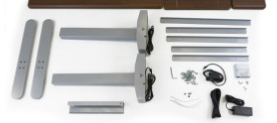
-
- Step 1: Pick the location for your desk. Instead of having to move your desk once it’s been built, pick a spot that is suitable for your needs in terms of space and lighting to start building your future workstation.
- Step 2: Prepare your tools. Usually, you’ll need only a set of Allen key bits and Phillips bits to use with your cordless screwdriver or impact driver.
- Step 3: Read the installation manual for your base carefully (preferably before you put your money down for it). Once the base arrives, remove all the parts from the packaging, check that you got all the parts you were supposed to receive, and then arrange them for assembly.
- Step 4: Place your desktop face down on a soft surface to make sure it doesn’t scratch. Doing this on top of a table instead of on the floor will save your back and make things go a lot faster.
- Step 5: Start assembling the legs by attaching the crossbars and the feet to the legs.
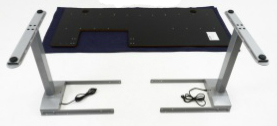
-
- Step 6: Once the legs are assembled, place them on top of your desktop and align the crossbars with the pre-drilled holes on the underside of the top. If your top doesn’t have pre-drilled holes, you will need to drill them yourself before attaching the base. We highly recommend using a drill bit with a depth stop so you don’t accidentally drill through your top.
- Step 7: Attach any other supporting crossbars or cord trays to the desktop. Then attach the power control unit.
- Step 8: Install the handset by aligning it with the two holes at the edge of the desktop. Again, if you have a custom top, you will need to measure and drill them yourself.
- Step 9: You may not want to put the drill away yet, as you may need it for installing a keyboard tray. If you’ve purchased a keyboard tray, make sure to read its own installation manual.
- Step 10:Plug the handset, leg motor cables, and power supply into the control unit. You can use cable guides to organize the cords.
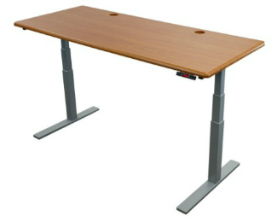
Now that you’re done, just flip the desk over, plug your new workstation into the power outlet, and start working!
Premium Electric DIY Standing Desk Lifting Bases
Premium DIY standing desk base frames offer the best frame you can buy and generally made in the USA or Europe. If you’re building a quality desk, these are the frames you’ll want to pick. They have more features, are more stable and will last longer because of the manufacturing quality.
1. iMovR Lander DIY Heavy-Duty Electric Standing Desk Base Frame Kit
The Lander is not only the top-of-the-line in DIY bases, it’s the top-of-the-line in standing desks overall. When sold as a desk system with a desktop from iMovR it’s the only standing desk that ships factory pre-assembled, and as such iMovR didn’t originally plan to offer it as a DIY base. However, its other features like the high-tech, Bluetooth-enabled height controller that syncs to your smartphone had the DIYers banging down the doors and a few months later iMovR met the demand with this state-of-the-art DIY base frame kit.
In all aspects of performance, the Lander is top-shelf: lift capacity of 365 lbs, transit speed of 1.6 inches per second, extraordinarily quiet dual precision motors, and a comfortable reach to accommodate the tallest users and the widest desks (easily 7 feet). Like the Freedom base, there’s an optional 6″ leg extension kit that gives this American-made base a top-end height of 56″, making it the tallest-reaching desk on the market.
Building a desk with the Lander base kit couldn’t be easier, and will shave time off your project as compared to just about any other DIY base (see the video). But the sizzle is in the unique height-control paddle with its high-res display and Bluetooth sync with your smartphone. Not only can you set up to four height presets per user, but each user can also set preferences for the built-in “health coach” to be reminded when it’s time to stand.
Price: $799
2. iMovR Lander Lite DIY Electric Standing Desk Base Frame Kit
iMovR has managed to take the industry’s top-rated original Lander base frame, keep 90% of the technology features and significantly lower the entry price with this new Lander Lite electric lifting base. Like the original, it’s made entirely in the USA from the highest quality materials and highest precision robotic manufacturing techniques, resulting in a superior value to the consumer. All the other tech-forward features like “gesture” height control paddle with Bluetooth and built-in health coach function, along with the smartphone app, are also present in this lower-cost version.
Price: $649
3. iMovR Jaxson Electric Standing Desk Lifting Base Frame Kit
It’s hard to say what we like the most about the Jaxson desk, it has so many distinguishing features over the dozens of ordinary, commodity-grade standing desks we’ve lab tested over the years. The ultra-reliable brushless motor technology in the base is obviously a standout, the Jaxson being the first standing desk in 24 years not to be built with brushed motors. The unobtrusive yet sleekly contoured handset is as “space-age” as it gets in standing desk controls, with built-in Bluetooth, an infrared presence sensor, and NFC. But it’s the overall styling that really grabs us, from the chamfered square columns to the rounded-end feet there are no hard edges to this desk. Where many standing desks have an industrial equipment aesthetic, the Jaxson offers warm colors and softened edges that just look nicer in any home or commercial office environment. And the industry-leading, 15-year, “top-to-bottom” warranty and 100-day satisfaction guarantee is classic iMovR. At only a slight premium in price compared to the most popular standing desk lifting frames out there today (all of which are made in China), the European-manufactured Jaxson base is massively disrupting the competitive landscape and finally give consumers the impetus to ditch the cheaply-made Asian goods. The bottom line is that the Jaxson is a true clean-sheet, future-proof design that has unique advantages over conventional brushed-motor designs, a very sleek aesthetic, and a great price point.
Price: $580
Commodity-Grade Electric Standing Desk Lifting Base Frames
Commodity DIY standing desk base frames are often made in China. They usually come at lower prices than premium electric DIY standing desk legs, but can suffer when it comes to quality, features and machining tolerances. Learn more about Why Some Standing Desks Shake More Than Others, How to Compare Warranties on Standing Desks, and How to Interpret Weight Ratings on Electric Standing Desk Lifting Bases.
1. iMovR Studio 470 DIY Light-Duty Electric Standing Desk Lifting Base
The iMovR Studio 470 is a commodity in terms of price point, the way it gets to that price point is through robotic automation and less metal. It is designed for smaller desks and, while it is very precisely machined, it doesn’t contain the amount of steel needed to be stable for larger and heavier desktops.
The iMovR Studio 470 standing desk base is perfect for the compact workstation. It is also the lightest-weight base available for DIY applications. Precision manufactured by robots the base is surprisingly good for its $329 price tag, with uncommon UL 962 and ANSI/BIFMA X5.5-2014 certification and a decent warranty this base will find its way into many home offices but commercial applications as well, such as compact call center desks.
The Studio 470 is uncommonly simple to assemble because it is a no-frills base. The argument being if you’re looking to build a small desk just for yourself there’s no need for all the extra metal and fancy multi-user controls found on bigger bases. That keeps shipping cost down throughout the supply chain, as well. Comes in black, white and silver. Perfect for the small Manhattan apartment or office space.
Price: $399
2. StandDesk Pro DIY Electric Standing Desk Lifting Base
Even before Autonomous launched their desk on Kickstarter, the pioneer in standing desk crowdfunding was StandDesk.co, offering the first desk under $400, at the time. The quality left a lot to be desired but the company persisted in making continuous improvements over next few years, releasing their new StandDesk Pro in 2017. While sharing a lot of characteristics with other Chinese bases it is not Jiecang-based, and it has some nice features not found on the others.
Read our detailed review for all the lab test results but the bottom line is that the StandDesk Pro sits between the Autonomous and the Jiecang products in terms of price, but offers slightly better quality than the rest of the pack. Prices start at $399.99 for the StandDesk Pro desk with no top.
Price: $754
3. Jiecang Electric Standing Desk Lifting Base
The adjustable-height base frame most commonly used by low-cost standing desk manufacturers—including Ergoprise, Fully, Uplift and the GeekDesk, to name but a few—is the Chinese-made Jiecang base. Unless you’re buying container loads, you can forget about contacting the manufacturer, but several of their OEM customers in the US sell the base standalone.
Fully sells a customized version of the Jarvis Standing Desk frame kit—with minor adaptations for claimed greater stability as compared to the stock product—for $445-$470 on Amazon. HumanSolution also sells their customized version of the UpLift Standing Desk frame kit for $449 on Amazon. Following is just a brief synopsis, and mind you that there will be slight variations between the different Jiecang resellers, mostly in the feet and in the hand controller design, as we discuss in the lab review.
Like the other bases we review here, the Jiecang can be set to varying widths, to accommodate tabletops from 48″ wide to 72″ or more. However, these bases become laterally unstable beyond 72″ width unless kept in the low to mid range of height adjustment, under 40″. Height adjustment range is from 23.75″ to 49.5″.
Price: $489
4. IKEA Idasen DIY Electric Standing Desk Underframe Kit
The Idasen is IKEA’s latest attempt at resuscitating their standing desk products after terminating the original Galant desk and suffering a horrendous reliability history with the IKEA Bekant Standing Desk. Besides being made with slightly higher grade components and a nicer hand controller featuring Bluetooth and a phone app to control your desk, the Idasen’s primary distinction is its styling, which is specifically intended to complement other Idasen collection furniture pieces.
On the plus side, the Idasen has a lot of metal in it, lowering its center of gravity and giving it better stability than the Bekant. On the minus side, the leg design creates an obstruction for those who like to swivel their legs out when getting out of their chairs. But the biggest limitation of the Idasen base is its highly limited versatility when it comes to desktop size options. It’s really designed for a narrow range of tops, from no smaller than 47.5″ x 27.5″ to no larger than 63.5″ x 31.5″. And its wimpy 165 lb lift capacity (before adding the desktop weight) should strike fear in the heart of any DIY standing desk builder, as it’s likely to have only slightly better reliability than the Bekant’s abysmal history, with its 150 lb capacity.
Price: $449 plus shipping
5. Autonomous SmartDesk 2 Standing Desk Lifting Base
The bottom-dollar electric base out there is the Autonomous SmartDesk 2, which started out as a Kickstarter campaign. As we delved deeply into in our review, “you get what you pay for” with this product. While its low price is very attractive, its design cuts every cost corner possible and leaves you with a shaky, weak, noisy and unreliable platform.
The Autonomous StandDesk DIY Kit is just their standard desk without the desktop, available in both Home Edition and Business Editions versions. The Home Edition is a single-motor, single-stage desk that’s weak as a kitten, slow, and exceedingly unreliable. We wouldn’t recommend it for any DIY standing desk. The Business Edition is minimally viable, with dual motors and dual-stage, a higher lift capacity, overload protection on the motors, and a crossbar for supporting wider desktops.
Price: $399
6. VIVO Single-Motor Hight Adjustable Lifting Base (V102E)
One of the cheapest standing desk frames available, we can only barely recommend this frame for a medium-sized user on a super-low budget. It will enable correct ergonomic positions because you can add a keyboard tray and monitor arm, but the experience won’t be pleasant because of persistent and infuriating controller errors and horrible wobbliness at standing height. Overall it is a flawed design with extraordinarily poor quality construction.
Price: $249.99
7. FEZiBO DIY Electric Standing Desk Base Kit
This is about the cheapest electric lifting base desk we’ve ever found in the retail market, and you can count on getting what you pay for in the poor overall quality. If you’re a medium-height user on a super-low budget, this desk should allow you to get into a solid ergonomic position since you can add accessories like a keyboard tray or monitor arm. However, you’re taking a risk with this Chinese-made desk leg kit because it has a track record of poor verified user reviews and zero warranty support.
Price: $179.99
Discontinued Standing Desk Frames
At WorkWhileWalking we’ve been lab testing and writing reviews of ergonomic office furniture and accessories for over a decade. In that time, we have seen many of the products we reviewed fall by the wayside. This is inevitable due to the cycle of continuous improvement, with new models supplanting their predecessors. Of course in some cases products weren’t as competitive as they needed to be, or their manufacturers ran into financial challenges (which very much accelerated as a result of the post-pandemic economy).
For whatever reason, these products now fall into the discontinued category, but we will still keep their reviews published and available to read. Whether you want to know more about the desk, monitor arm, etc. that you bought years ago, need more info because someone is selling one second hand, or just want to compare current offerings with what was available in the past, these reviews will remain here for your reference.
1. iMovR Freedom DIY Standing Desk Base
iMovR’s new Freedom Standing Desk Line takes cheaply-made imports to task, combining American-made quality with an impressively low price point.
Price: $524


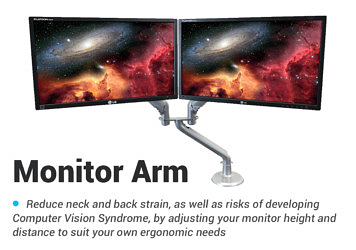
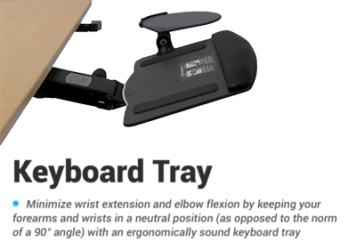
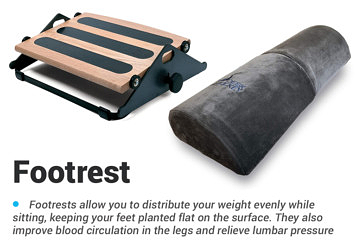
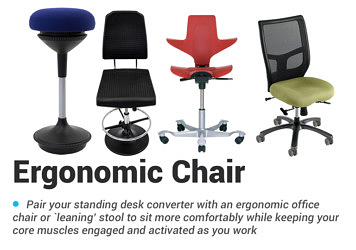
2 Comments
Leave a response >